
Rebel 250 Photo Essay Series
Tales of Two Rebels

Honda Rebel CMX-250
Classic -vs- Contemporary
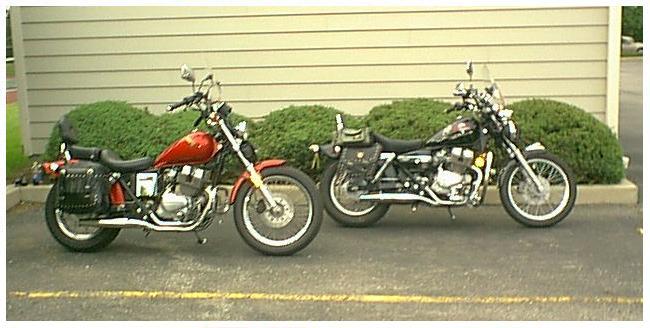
Red 86/87 'classic' 250 and Black 2000 'contemporary' 250
Thanks to Indiana_LADY_, i was able to take a set of pics of both a classic 80's Rebel 250
and a modern contemporary 90's/2000plus version of the Rebel 250 parked side by side
Below you can see some of the minor differances in the design and details of the two ...
other than the tank decals that is - LOL ... (BTW - the decal has changed for 2004 as well)
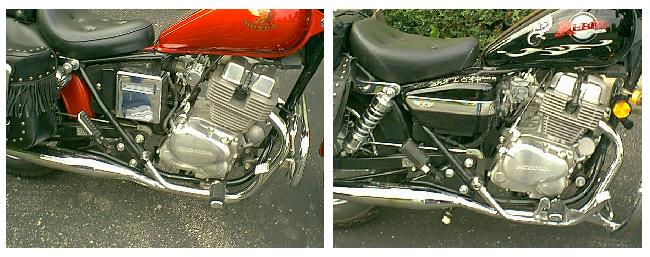
Battery Side Covers
One of the most obvious differances is the chrome side covers on the classics
have been replaced with the redesigned plastic ones on the modern bikes
do keep in mind that the side cover mounting points differ as well
Also note the slight ?apparent differance? in brake pedal length
as well as the differance in mounting bracket for driver foot pegs

Spark Plug Boots
This is a minor differance but is nevertheless there...
The classic has an angled 'L' boot and the modern has a straight one
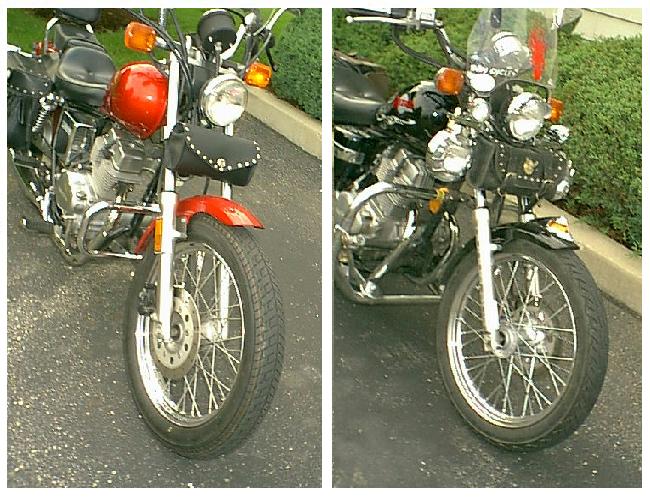
Front Views
Several differances are apparent in these shots ...
First i would like to point out that the seats differ on the two versions
The classic seat is narrower and the buttons are in a diamond pattern
the modern seat is noticably wider and the buttons are in a square pattern
i'm sorry this is about the best shot i managed to capture
(i thought i had shots of it at the time - apparently not)
Next i would like to point out the fork legs ...
on the classic the front side refelctor is molded into the fork lowers
on the modern bike they are on the down tube and the forks are smooth
you can also see that the front brake setup is mounted on different sides
on the classic the caliper and rotor are on the right side of the fork
on the modern bike they are located on the left (low side when parked)
If you look closely you can spot the differance in color of the levers and speedo
Black on the classic bikes and brushed aluminum/chrome on the newer bikes
also, while not really clear in this set of pics, the turn signal locations differ
the front turn signals on the classics are mounted on the sides of the bar risers
and are responsible for the traditional rebel tank dents that drive owners crazy
the newer bikes have them mounted on fork clamps instead of the risers
(you can still see the round mounting boss on the sides of the risers tho)
also in this shot you may notice the classic owner has added a stainless plate
to raise the front fender higher to accomodate the larger front tire rubber
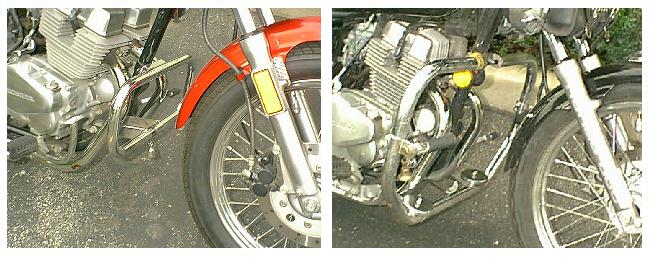
Case -vs- Engine Guards
While it is more of a differance in aftermarket products design than due to model years
this set of pics does show the two guard styles available for the Rebel 250's
- here the classic has the abbreviated mini style often called a 'case' guard
- while the modern bike has the full sized 'engine' guard (AKA: harley hoops)
This set of pics again shows the front side reflector location differances
and also the fork lowers and brake location differances between the models
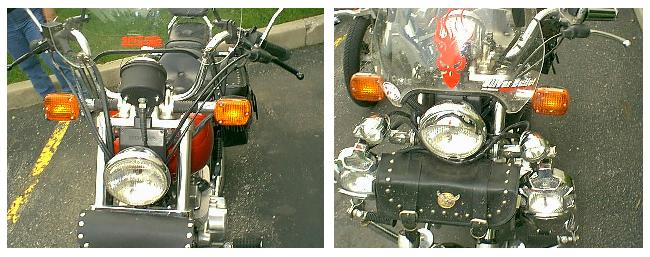
Front Head Shot
Although the windsheild on the black bike may be in the way ...
you might be able to pick out the turn signal mounting location differances
and please do check out the handlebar style differance - the handlebars are what
is responsible for most of the differance in cockpit 'feel' of the two versions
and if you peek close you can glimpse the seat differance on the classic red bike

Dash Panel Shot
Again, notice the differance in handlebar styles between the two models
and look close at the actual dash panel - count the number of indicator lights ...
-on the classic, the neutral and turn signal indicators are on either side of key
and the blue high beam idicator is the small dot located on the speedo face itself
- on the contemporary, the neutal light has been moved below the turn signal light
and the high beam indicator is now on the left side of key, this is because of a
safety feature added to the newer models, the speedo dot is now amber and marked
with an 'S' to indicate that the kick stand is down - this is due to the cutoff
switch that has been added to prevent the engine from running while the bike is
in gear if the stand is down - to start the bike must be in neutral gear, or,
the kick stand must be in the up position - this affects the advice to lower the
kick stand to trigger traffic light sensors as that will kill the engine on the
newer models with this safety feature - it also catches some new owners off guard
and prompts 'why won't my bike start' theads on the message boards ...
go back up and check the engine guard pic set for magnets mounted on the black bike
to help trip the electro-magnetic traffic light sensor loops at stop lights
oh, and one last note before moving on - if you look at the newer style dash
on the lower left is a square which is stamped with the Honda wing logo
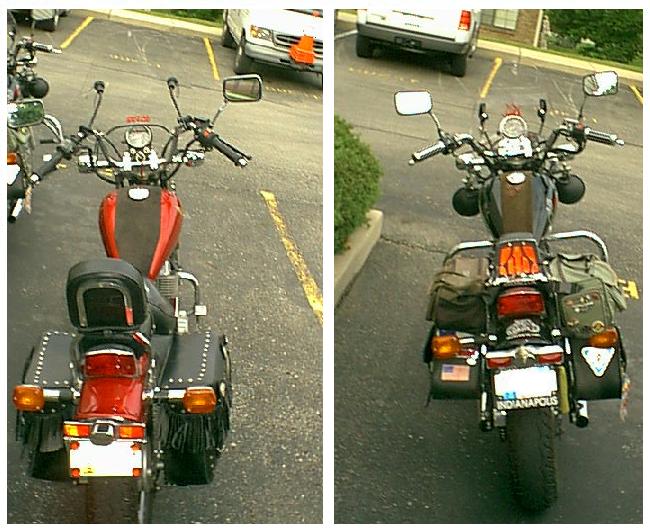
Rear Views
this is probably the best shot for noting the differances in handlebar styles
it also shows the two varieties of engine guards and how they differ in size
it might also be a good place to call attention to the sissybar style differances
the classic sports a much beefier and better 'traditional' sissy bar (?from jacks?)
while the modern has a slimline Mapam brand sissybar (piece of crap - see details)
a detail that might not be readily obvious is the differance in the gas tanks ...
the classic tank has a more squared off 'flat top' shape to its design
while the newer tank is more smoothly rounded in contour from top to sides

Click on this icon logo to RETURN to BAILEY Motorcycle MAINpage
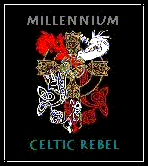
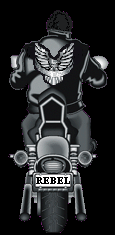

Please contact BABailey at MillenniumRebel@yahoo.com about information on this page

















